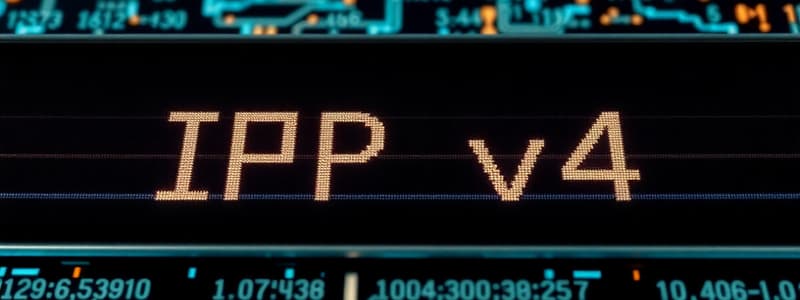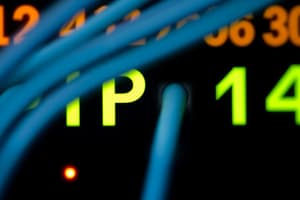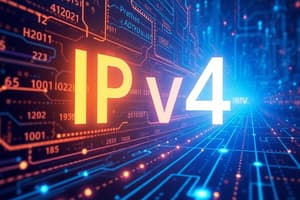Podcast
Questions and Answers
What best describes the nature of a unicast packet?
What best describes the nature of a unicast packet?
- It includes one source device communicating with multiple hosts.
- It uses a broadcast address for its destination.
- It has a destination IP address that targets one specific recipient. (correct)
- It is sent to multiple devices simultaneously.
Which of the following ranges denotes valid IPv4 unicast host addresses?
Which of the following ranges denotes valid IPv4 unicast host addresses?
- 0.0.0.0 to 1.1.1.1
- 239.255.255.255 to 255.255.255.255
- 1.1.1.1 to 223.255.255.255 (correct)
- 224.0.0.0 to 239.255.255.255
What is true about broadcast transmissions in an IPv4 network?
What is true about broadcast transmissions in an IPv4 network?
- They use unicast addresses for destination.
- They can target a single device on the network.
- They must be processed by all devices in the same broadcast domain. (correct)
- They send packets exclusively to multicast clients.
How does multicast transmission optimize network traffic?
How does multicast transmission optimize network traffic?
What best characterizes a directed broadcast?
What best characterizes a directed broadcast?
Which of the following is true regarding multicast addresses?
Which of the following is true regarding multicast addresses?
What subnet mask notation corresponds to 255.255.255.0?
What subnet mask notation corresponds to 255.255.255.0?
What distinguishes a limited broadcast from a directed broadcast?
What distinguishes a limited broadcast from a directed broadcast?
Which IPv4 address class is designed to support extremely large networks, accommodating more than 16 million host addresses?
Which IPv4 address class is designed to support extremely large networks, accommodating more than 16 million host addresses?
What is the primary function of NAT (Network Address Translation) in relation to private IPv4 addresses?
What is the primary function of NAT (Network Address Translation) in relation to private IPv4 addresses?
Which address range is designated for link-local addresses, also known as APIPA?
Which address range is designated for link-local addresses, also known as APIPA?
What is the purpose of subnetting in a network?
What is the purpose of subnetting in a network?
Which of the following statements is true about public IPv4 addresses?
Which of the following statements is true about public IPv4 addresses?
What is the role of ARP in an Ethernet LAN?
What is the role of ARP in an Ethernet LAN?
Class D addresses are primarily used for what purpose?
Class D addresses are primarily used for what purpose?
What can excessive broadcasts in a large broadcast domain negatively affect?
What can excessive broadcasts in a large broadcast domain negatively affect?
What does the IANA do in relation to IPv4 and IPv6 addresses?
What does the IANA do in relation to IPv4 and IPv6 addresses?
Which multicast address is specifically reserved for OSPF communication?
Which multicast address is specifically reserved for OSPF communication?
What is the range of private IPv4 addresses defined by RFC 1918 for Class B?
What is the range of private IPv4 addresses defined by RFC 1918 for Class B?
What must happen to a private address before packets can be routed to the internet?
What must happen to a private address before packets can be routed to the internet?
Which of the following is a correct description of loopback addresses?
Which of the following is a correct description of loopback addresses?
What is a characteristic of link-local addresses (APIPA)?
What is a characteristic of link-local addresses (APIPA)?
What was the primary purpose of classful addressing in IPv4 networks?
What was the primary purpose of classful addressing in IPv4 networks?
Which address range specifically falls under Class A addressing?
Which address range specifically falls under Class A addressing?
Why were classful addressing methods deprecated in the mid-1990s?
Why were classful addressing methods deprecated in the mid-1990s?
What type of address is used for multicast transmissions within a network?
What type of address is used for multicast transmissions within a network?
What does NAT stand for in the context of IPv4 addresses?
What does NAT stand for in the context of IPv4 addresses?
Which class of IPv4 address can support the largest number of hosts within a single network?
Which class of IPv4 address can support the largest number of hosts within a single network?
Which of the following addresses is typically not routable on the internet?
Which of the following addresses is typically not routable on the internet?
What is the purpose of the OSPF multicast address 224.0.0.5?
What is the purpose of the OSPF multicast address 224.0.0.5?
What is a primary reason for segmenting networks into smaller subnetworks?
What is a primary reason for segmenting networks into smaller subnetworks?
Which of the following statements accurately describes the role of the Internet Assigned Numbers Authority (IANA)?
Which of the following statements accurately describes the role of the Internet Assigned Numbers Authority (IANA)?
What happens to a broadcast packet when it reaches a router?
What happens to a broadcast packet when it reaches a router?
What is a disadvantage of a large broadcast domain?
What is a disadvantage of a large broadcast domain?
Which method allows a host to communicate with multiple devices without causing excessive network traffic?
Which method allows a host to communicate with multiple devices without causing excessive network traffic?
Which range of IP addresses is reserved for multicast transmission in IPv4?
Which range of IP addresses is reserved for multicast transmission in IPv4?
What protocol is typically used for acquiring an IPv4 address configuration on a local network?
What protocol is typically used for acquiring an IPv4 address configuration on a local network?
What defines a directed broadcast?
What defines a directed broadcast?
Which of the following best describes unicast transmission?
Which of the following best describes unicast transmission?
Which statement correctly explains the function of switches in a broadcast domain?
Which statement correctly explains the function of switches in a broadcast domain?
What is the impact of excessive broadcasts in a large broadcast domain?
What is the impact of excessive broadcasts in a large broadcast domain?
How does subnetting improve network security?
How does subnetting improve network security?
Why is subnetting considered an essential skill for network administrators?
Why is subnetting considered an essential skill for network administrators?
Flashcards are hidden until you start studying
Study Notes
IPv4 Addressing
- Unicast Transmission is one-to-one communication.
- Unicast packets have a destination unicast address for a single recipient.
- The source address must be a unicast address.
- IPv4 unicast host addresses range from 1.1.1.1 to 223.255.255.255.
- Broadcast Transmission is one-to-all communication.
- Broadcast packets have all ones (1s) in the host portion of the destination address.
- All devices in the same broadcast domain process broadcast packets.
- Broadcast packets can be directed (to all hosts on a specific network) or limited (to 255.255.255.255).
- Routers generally don't forward broadcasts.
- Multicast Transmission is one-to-many communication.
- A single packet is sent to a selected set of hosts that subscribe to a multicast group.
- Multicast packets have a destination multicast address, which is in the range of 224.0.0.0 to 239.255.255.255.
- Hosts that receive specific multicast packets are called multicast clients.
- Multicast clients subscribe to multicast groups via client programs.
- Each multicast group has a unique IPv4 multicast destination address.
IPv4 Address Types
- Public IPv4 Addresses are globally routable between Internet Service Provider (ISP) routers.
- They can be used on the internet.
- Private IPv4 Addresses are used for internal network use and are not routable on the internet.
- They are defined in RFC 1918.
- Private address ranges:
- 10.0.0.0/8: 10.0.0.0 to 10.255.255.255
- 172.16.0.0/12: 172.16.0.0 to 172.31.255.255
- 192.168.0.0/16: 192.168.0.0 to 192.168.255.255
- Special Use IPv4 Addresses have limitations on how they can be used.
- Loopback addresses (127.0.0.0 /8 or 127.0.0.1 to 127.255.255.254) are used by a host to direct traffic to itself.
- 127.0.0.1 is the most common loopback address.
- Link-local addresses (169.254.0.0 /16 or 169.254.0.1 to 169.254.255.254) are self-assigned addresses used by Windows clients when they can't obtain an IP address through other methods.
- Also known as Automatic Private IP Addressing (APIPA) addresses.
- Loopback addresses (127.0.0.0 /8 or 127.0.0.1 to 127.255.255.254) are used by a host to direct traffic to itself.
IPv4 Addressing History
- Classful Addressing (RFC 790) was used to allocate IPv4 addresses based on three classes:
- Class A (0.0.0.0/8 to 127.0.0.0/8): Supported very large networks with over 16 million hosts.
- Class B (128.0.0.0 /16 - 191.255.0.0 /16): Supported moderate to large networks with up to 65,000 hosts.
- Class C (192.0.0.0 /24 - 223.255.255.0 /24): Supported small networks with up to 254 hosts.
- Classful Addressing was deprecated in the mid-1990s due to inefficient IPv4 address space allocation.
IPv4 Address Management
- Internet Assigned Numbers Authority (IANA) manages and allocates IPv4 and IPv6 addresses globally.
- Regional Internet Registries (RIRs) are responsible for assigning IP address blocks to ISPs and organizations.
Broadcast Domains and Network Segmentation
- Broadcast Domains are areas on a network where all devices receive broadcast packets.
- Switches propagate broadcasts out all interfaces except the one they received it on.
- Routers do not forward broadcasts, creating separate broadcast domains.
- Large Broadcast Domains can lead to excessive broadcast traffic and slow network performance.
- Subnetting divides a network into smaller broadcast domains (subnets) to reduce broadcast traffic and improve network performance.
- Subnets use longer prefix lengths to identify networks.
- Subnetting benefits:
- Reduced network traffic.
- Improved network performance.
- Enhanced security by controlling communication between subnets.
- Reduced impact of abnormal broadcast traffic.
Key Processes and Protocols
- ARP (Address Resolution Protocol): Sends Layer 2 broadcasts to discover the MAC address associated with a known IPv4 address.
- DHCP (Dynamic Host Configuration Protocol): Sends broadcasts to locate a DHCP server and acquire IPv4 address configurations.
- NAT (Network Address Translation): Used to translate between private IPv4 and public IPv4 addresses.
- OSPF (Open Shortest Path First): A routing protocol that uses multicast transmissions for communication between routers.
Studying That Suits You
Use AI to generate personalized quizzes and flashcards to suit your learning preferences.




